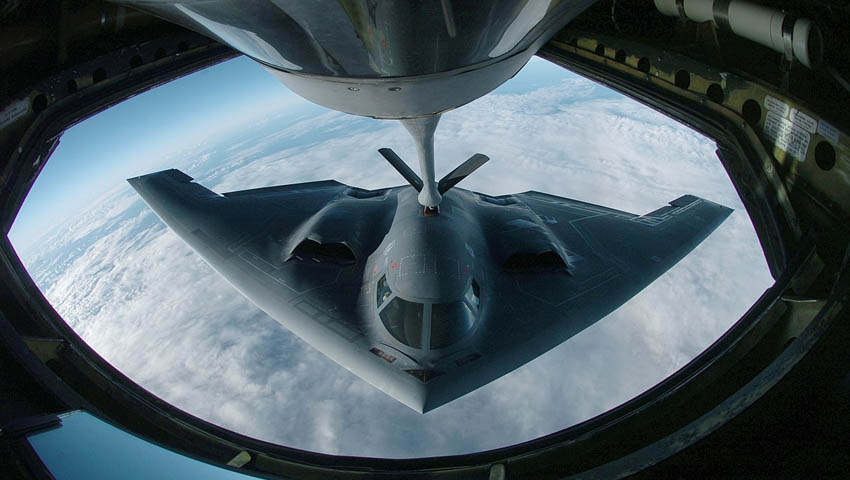Two US Air Force bombers recently participated in a joint US-Australian long-range strike exercise in the Northern Territory.
To continue reading the rest of this article, please log in.
Create free account to get unlimited news articles and more!
The B-1B Lancer and B-2 Spirit aircraft flew from Guam and Diego Garcia, respectively, and operated over Delamere, Bradshaw and Mount Bundey training areas during August.
The activity saw the US aircraft integrate with the Australian Army and US Marine Rotational Force – Darwin, providing a highly advanced training opportunity.
The US aircraft exercised both live and inert munitions on the training areas allowing the Australian and US forces the opportunity to practice their skills in both traditional and modern forms of target location, strike confirmation, and damage assessment.
While the B1-B and B-2 aircraft did not land in Australia, they were supported by US Air Force air-to-air refuelling aircraft that flew out of RAAF Base Darwin.
The aircrews of the refuelling aircraft were managed under strict Federal and Territory COVID-19 requirements while transiting through Australia.
Australian involvement included Tiger Armed Reconnaissance Helicopters and joint terminal attack controllers from Darwin based Army units.
The ability of both militaries to successfully complete this training during the COVID-19 pandemic is a demonstration of the resilience of the long-standing alliance co-operation.
US bombers have been visiting Australia since the 1940s, with the first B-1B Lancer arriving in 1995.
The B-1A was initially developed in the 1970s as a replacement for the B-52. Four prototypes of this long-range, high speed (Mach 2.2) strategic bomber were developed and tested in the mid-1970s, but the program was cancelled in 1977 before going into production. Flight testing continued through 1981.
The B-1B is an improved variant initiated by the Reagan administration in 1981. Major changes included and additional structure to increase payload by 74,000 pounds, an improved radar and reduction of the radar cross section by an order of magnitude. The inlet was extensively modified as part of this RCS reduction, necessitating a reduction in maximum speed to Mach 1.2.
The US eliminated the nuclear mission for the B-1 in 1994. Even though the Air Force expended no further funding to maintain nuclear capabilities, the B-1 was still considered a heavy bomber equipped for nuclear armament until 2007.
The conversion to conventional only began in November 2007 under the original START treaty and was completed in March 2011 under the New START treaty.
The first B-2 was publicly displayed on 22 November, 1988, when it was rolled out of its hangar at Air Force Plant 42, Palmdale, California. Its first flight was 17 July 1989. The B-2 Combined Test Force, Air Force Flight Test Centre, Edwards Air Force Base, California, is responsible for flight testing the engineering, manufacturing and development aircraft on the B-2.
Whiteman AFB, Missouri, is the only operational base for the B-2. The first aircraft, Spirit of Missouri, was delivered on 17 December 1993. Depot maintenance responsibility for the B-2 is performed by Air Force contractor support and is managed at the Oklahoma City Air Logistics Center at Tinker AFB, Oklahoma.
The combat effectiveness of the B-2 was proven in Operation Allied Force, where it was responsible for destroying 33 per cent of all Serbian targets in the first eight weeks, by flying non-stop to Kosovo from its home base in Missouri and back. In support of Operation Enduring Freedom, the B-2 flew one of its longest missions to date from Whiteman to Afghanistan and back.
The B-2 completed its first-ever combat deployment in support of Operation Iraqi Freedom, flying 22 sorties from a forward operating location as well as 27 sorties from Whiteman AFB and releasing more than 1.5 million pounds of munitions.
The aircraft received full operational capability status in December 2003. On 1 February 2009, the Air Force's newest command, Air Force Global Strike Command, assumed responsibility for the B-2 from Air Combat Command.
Stephen Kuper
Steve has an extensive career across government, defence industry and advocacy, having previously worked for cabinet ministers at both Federal and State levels.

 Login
Login








